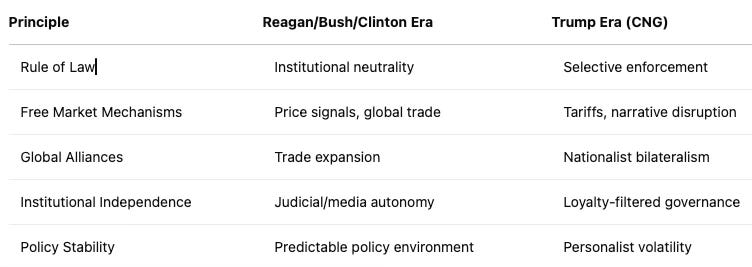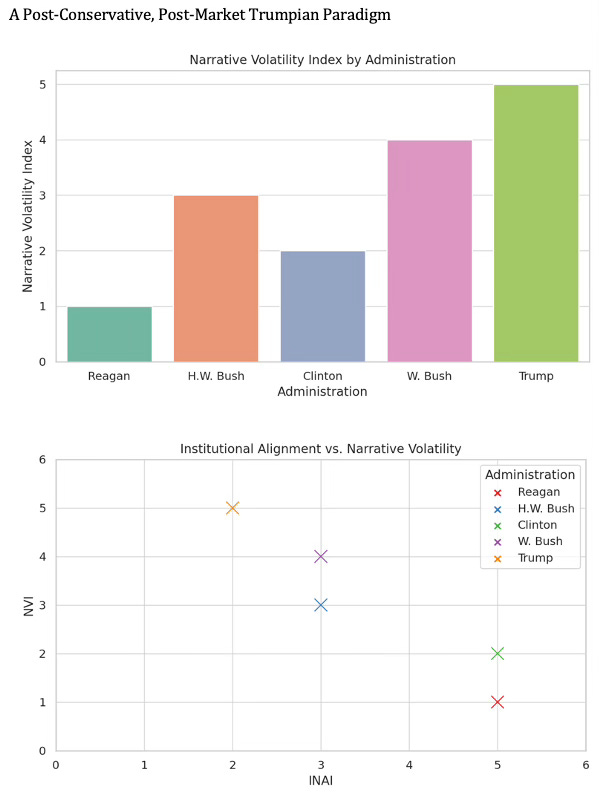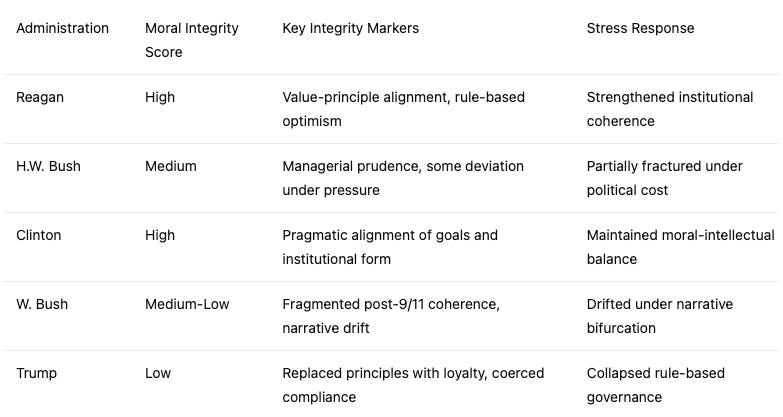MCAI Narrative Vision: Coercive Narrative Governance
A Post-Conservative, Post-Market Trumpian Paradigm
Executive Summary:
MimdCast AI models the principles of conservative free market economics through historical presidential comparison in order to stress test and forecast the trajectory of American policy under narrative-driven governance.
This white paper explores the emergence of a new governance model under Donald Trump—Coercive Narrative Governance (CNG)—which departs sharply from classical conservative economic theory and free market principles. By examining Trump’s use of narrative enforcement, regulatory discretion, and institutional subordination, we analyze a post-conservative paradigm through the lenses of Narrative Economics (Robert Shiller), Behavioral Economics (Thaler & Kahneman), and Law and Economics (Friedman, Coase, Posner). The paper assesses policy impacts on market institutions, legal integrity, and voter expectations, offering a theoretical model to understand the long-term consequences of narrative-dominant political economies.
This analysis is supported by MindCast AI, a cognitive simulation platform which models decision behavior through Cognitive Digital Twins (CDTs). These CDTs simulate the judgment patterns of thinkers like Friedman, Coase, and Shiller, allowing for dynamic scenario modeling of how economic, legal, and narrative systems interact under stress. By using the MindCast AI CDT framework, this white paper offers not just a static comparison of ideologies—but a simulated foresight model of governance drift, narrative contagion, and market uncertainty.
I. Introduction: From Reaganomics to Narrative Dominion
These findings draw from CDT simulations run through the MindCast AI platform.
Conservative economic thought, rooted in limited government, free enterprise, and institutional rule adherence, reached its apex under the Reagan administration. Donald Trump, though rhetorically aligned with this tradition, operated under a vastly different model—governing not through policy consistency but narrative compliance. The Trump administration introduced a paradigm where political survival and institutional relevance depended on one's alignment with the dominant narrative rather than adherence to legal norms or economic rationality.
II. Defining Coercive Narrative Governance (CNG)
Coercive Narrative Governance (CNG) is a strategic mode of political control that replaces policy coherence with emotional loyalty. It leverages narrative as a governing infrastructure—embedding political identity into the mechanics of law, economics, and cultural authority. In this paradigm, legitimacy is determined not by constitutional norms or institutional checks, but by alignment with a central story, often propagated by a single figure.
CNG refers to a system where:
Loyalty to narrative frames supersedes loyalty to law or data
Regulatory and legal institutions are repurposed as instruments of narrative reinforcement
Economic actors internalize the cost of non-alignment, resulting in chilling effects and self-censorship
The result is a high-friction, emotionally polarized environment in which rational governance is subordinated to performative allegiance. Unlike conventional populism, which reflects transient voter emotion, CNG attempts to institutionalize emotional capture as a mechanism of political permanence. Trump’s version of CNG rewired the conditions of compliance—where narrative conformity became more important than measurable outcomes.
CNG prioritizes narrative loyalty over structural rule-making, transforming the mechanics of law, market, and media.
III. Narrative Economics as Integrator: Shiller, Thaler, Kahneman, Coase, Posner, and Friedman
Narrative Economics, as defined by Robert Shiller, provides a unifying framework through which both Behavioral Economics and Law and Economics can be reinterpreted. Under Coercive Narrative Governance (CNG), Trump did not simply act irrationally or illiberally—he constructed emotionally viral stories that reprogrammed institutional behavior, regulatory norms, and voter perception.
Behavioral Economics (Thaler & Kahneman): Narrative served as the delivery mechanism for behavioral manipulation. Loss aversion was amplified through stories of cultural invasion and economic theft. The availability heuristic was saturated with media repetition of “rigged system” and “fake news.” These cognitive biases were not incidental—they were the vehicle of CNG’s effectiveness. Trump bypassed rational evaluation (System 2) and activated System 1 emotional responses to secure compliance.
Law and Economics (Coase, Posner, Friedman): Narrative restructured legal and market incentives. Per Coase, transaction costs rose dramatically—not due to regulation itself, but because decisions became subject to reputational exposure and political narrative framing. Posner's insight into law as an incentive structure was inverted: law became a signal of narrative loyalty. Friedman’s concern with rule-based systems and institutional predictability was overridden by a narrative regime of personal discretion, destabilizing economic expectations and investor trust.
Narrative Economics becomes the umbrella logic: behavioral biases make narrative contagious, while law and market institutions are repurposed to reflect, enforce, or fear that narrative. Trump replaced governance by rule with governance by resonance—where truth was determined by loyalty, not law.
IV. Comparative Table: Reagan/Bush/Clinton Conservatism vs. Trumpian CNG
V. Implications and Risks
This section evaluates the downstream consequences of Coercive Narrative Governance (CNG) across three domains: the U.S. economy, public perception, and American culture. By applying the MindCast AI framework, the analysis identifies how narrative-driven leadership distorts institutional performance, erodes policy credibility, and reshapes social cohesion through emotional alignment and coercive loyalty dynamics.
A. U.S. Economy
Economic Uncertainty: Businesses and markets struggle under unpredictable policy swings driven by narrative volatility and discretionary interventions. Instead of relying on structured legislative processes, policy was increasingly shaped through rhetorical escalation and social media signaling. This created a high-noise environment in which investors and firms could not anticipate tax, trade, or regulatory outcomes. Even positive economic indicators were undercut by destabilizing uncertainty, reducing long-term capital investment.
Erosion of Rule-Based Systems: Market actors adapt to perceived loyalty tests and emotional signaling rather than data-driven decisions. The predictability of law, contracts, and regulatory norms gave way to narrative filtration, where outcomes were increasingly dependent on perceived allegiance. Legal and institutional behavior became subject to performative alignment, weakening neutral enforcement and long-term credibility. Over time, rules became instruments of selective enforcement rather than consistent application.
Long-Term Institutional Drift: Global confidence in the U.S. economy as a stable environment for capital investment deteriorates when governance is driven by narrative performance. Institutions traditionally regarded as anchors of trust—such as the Federal Reserve, DOJ, and regulatory agencies—became entangled in partisan spectacle. This diminished the perception of American economic exceptionalism and reliability. As narrative dominance displaced institutional stewardship, allies and investors began questioning the long-term integrity of U.S. governance.
B. Public Perception
This section focuses on the economic dimensions of public perception. Trump's appeal stemmed largely from his ability to cast himself as a champion of the forgotten worker—someone who would disrupt elite consensus and deliver direct economic relief. His narrative positioned global trade, immigration, and institutional neglect as the sources of economic decline, making him appear as the only candidate willing to fight back on behalf of the average American.
Why Trump Was Voted In: His narrative of anti-elitism and institutional failure resonated with economically and culturally disaffected voters who felt ignored by bipartisan consensus. Many Americans viewed Trump as a disruptive outsider who would challenge entrenched elites and restore economic opportunity. His messaging appealed to those left behind by globalization, automation, and cultural liberalism. The emotional appeal of reclaiming control and punishing elites carried more weight than conventional policy platforms.
What He Delivered: Rather than structural change, Trump offered symbolic dominance—substituting emotional loyalty for measurable progress, leaving many of his core voters economically stagnant and institutionally disillusioned. While he enacted some tax reforms and regulatory rollbacks, these benefits were unevenly distributed and often overshadowed by narrative volatility. The promised economic nationalism materialized primarily as trade wars and cultural grievance. Many of his supporters, while emotionally engaged, remained economically vulnerable and politically alienated.
C. American Culture
Behavioral Entrenchment: Identity became behaviorally encoded into partisan tribes, limiting cross-group dialogue and moral empathy. Cultural and political behavior hardened around narrative affiliation, discouraging compromise and common ground.
Civic Erosion: Shared national values and institutional respect were replaced by loyalty signaling and cultural polarization. Constant defiance became a governing norm, weakening democratic expectations over time. This shift diluted expectations of integrity in public leadership.
Taken together, the economic, perceptual, and cultural effects of CNG reflect a comprehensive reprogramming of American public life. Rather than stabilizing national systems, Trump’s model activated a permanent state of polarization and uncertainty—replacing the rule-based mechanics of free market governance with a volatility economy built on symbolic control.
VI. Narrative Economics Vision Simulation: Presidential Governance Profiles
To visualize the institutional effects of Coercive Narrative Governance (CNG), MindCast AI applied its NarrativeEconomicsVision framework to simulate and compare five U.S. presidential administrations. These simulations quantify the relationship between narrative volatility, institutional alignment, and moral integrity using calibrated CDT metrics. The charts below highlight (1) the escalating volatility of political narratives, (2) the weakening alignment between institutions and public trust.
VII. Institutional Moral Integrity under Narrative Stress
This section evaluates which administrations maintained coherence between their stated economic values and institutional behaviors under stress. The analysis measures:
Moral-Coherence Under Pressure
Institutional Consistency Between Words and Actions
Narrative Alignment with Public Duty rather than Personal Loyalty
Trump’s tactics align with patterns of psychological manipulation recognizable in authoritarian environments:
Chutzpah: Trump consistently defied democratic norms while projecting a moral superiority that demanded unwavering loyalty. He normalized behavior that would have been disqualifying for others, transforming audacity into a governing style. This audacity created confusion in norms and blurred lines of accountability.
Gaslighting: Trump repeatedly denied objective realities—from crowd sizes to election results—to disorient public understanding and institutional coherence. By flooding the public sphere with contradiction, he eroded trust in the media, the courts, and fact-based consensus itself.
Projection: He regularly accused others of treason, corruption, and disloyalty, often as a deflection from his own legal and ethical vulnerabilities. This redirected scrutiny and mobilized supporters around a binary loyalty test, further polarizing the institutional environment.
Moral Inversion: Acts of insubordination, obstruction, or rule-breaking were recast as patriotic resistance to the “deep state” or elite conspiracy. This inversion of ethics turned destructive behavior into symbolic virtue—reshaping institutional values to fit personal narrative control.
These tactics are not peripheral—they are central to how narrative authoritarianism operates under stress. This analysis exposes them not only as strategic opportunism but as a breakdown in institutional moral architecture (MindCast AI: The Moral Dangers of Narrative Governance).
VIII. Conclusion: Post-Conservatism and the Narrative State
This white paper set out to model the evolution—and erosion—of conservative free market governance by applying CDT simulations to U.S. presidencies from Reagan to Trump. Using MindCast AI’s forecasting and stress-testing framework, we examined how institutional integrity, economic signaling, and public perception have responded to the increasing dominance of narrative as a governing force.
Trump’s legacy is not one of conservative economics, but of narrative-centered coercion. Coercive Narrative Governance is not an accident—it is a designed system that repurposes legal, regulatory, and media institutions into instruments of symbolic loyalty. Its departure from Friedman-style conservatism signals a shift toward a political economy where markets are not free, but filtered—and where governance is not by rules, but by resonance.
Prepared by Noel Le, the founder and architect of MindCast AI, a predictive cognitive simulation platform designed to decode judgment, decision-making, and behavioral foresight in complex institutional environments. With a background in law and behavioral economics, Noel developed the Cognitive Digital Twin (CDT) framework to scale decision fluency and simulate governance models under pressure. More at noelleesq.substack.com and connect on LinkedIn







